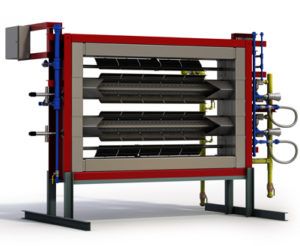Duct burners in HRSGs

Natcom duct burner[/caption]
Duct burner is a unique tool that expands the operating range of HRSGs. Renewable technologies can be integrated with duct burners for an uninterrupted power or steam supply.
At Power Gen International 2019, Greg Kaup, director for product and process development at Cleaver Brooks gave a presentation on duct burners. Below are some excerpts.
In power plants, duct burner quickly restores steam supply to the HRSG when one of two CTG/HRSG blocks trip. In a process plant, it maintains the required steam production while reducing power generation (part load firing). In plants with solar and fossil power generation, a duct burner will restore production when solar power is lost.
Two firing modes are there. Fresh air firing allows steam generation when combustion turbine is off line. Exhaust flow distribution devices are required. Forced draft or induced draft fan with 75% to 100% capacity are required. On the fly switchover is possible and seal air dampers help isolate combustion turbine and fan.
Augmenting air firing extends firing capacity at low oxygen level in CT exhaust. It is often required for the second burner in a double burner HRSG. This firing reduces HRSG efficiency. In peaking plants, the steam generation is double in 5 to 10 minutes. Duct burner can be added to account for CTG and HRSG degradation.
Firing Temperature: Low ≤ 1250°F. Medium ≤ 1450°F. High - 1450°F to 1600°F
In natural gas combustion, flame length is 6’ to 8’ and firing chamber length is 14’ to 16’. Turndown ratio is 10 to 1 overall or per runner.
In liquid fuel or dual fuel combustion, 20’ flame length and 26’ firing chamber length. Turndown ratio is 3 to 1.
As far as emission performance is concerned, NOx emissions on a lb/MMBTU basis vary slightly with firing rate. CO emissions on a lb/MMBTU increase as firing rate decreases. On a lb/hr they stay relatively constant. Emissions at turndown are only guaranteed on a lb/hr basis.